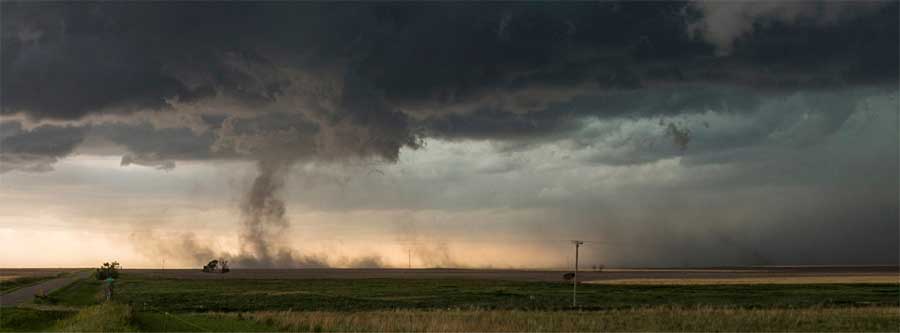
An Oklahoma State University assistant professor and Extension equine specialist shares disaster-preparation guidance for horse owners, as much of the country's Heartland prepares for severe, and possibly tornadic, weather
As the sirens wailed over Oklahoma City, the city took shelter as an F5 tornado continued its devastating path toward the nearby town of Moore.
“I sat in a room surrounded by friends and colleagues,” Oklahoma horse owner and Valley Vet Supply employee, Aimee Robinson said. “In unexplainable terror, we watched the local news as the tornado made its way closer toward us. It was heading right toward my horse’s boarding stable. There was nothing that I could do. ”
Among those whose lives were taken by the Moore tornado on May 20, 2013, were 150 horses unable to escape its mile-wide wrath.
“As soon as sirens let up, I drove as fast as I could to the barn, dodging downed trees and debris and parking more than a mile away, as close as I could get to our barn. I ran toward the affected area not knowing if my horse would be injured, or if she was even alive,” recalled Robinson. “I mentally prepared myself for the worst, and to my disbelief as I crested the final hill, our barn was still standing. Indefatigable was still there in her stall -- shaking, but alive. The training barn nearest to ours took a direct hit and lost everything.”
Kris Hiney, PhD, Oklahoma State University assistant professor and Extension equine specialist, specializes in disaster preparedness for horses and livestock.
When asked the No. 1 question, whether to keep horses stalled or turn them loose in a pasture for better hopes of survival, Dr. Hiney replied, “It’s a hard call to know what’s best during severe weather.”
“Overall, being sheltered is better. But it really depends on how sturdy the barn is. We advise to not have any loose material that could be a flying projectile and to have everything locked down tight,” Dr. Hiney said.
When faced with the decision to stall horses or set them free, it is critical to keep in mind the effect flying debris can have on a horse’s safety, during tornadoes or hurricanes, should they be kept out in the elements. Understanding that not all facilities will have a barn or sturdy shelter for horses to weather the storm and with the quick development of supercells, there may not be time to safely bring horses inside. Keeping close watch on the weather is crucial to planning ahead, helping to ensure your horse’s safety.
When facing risk of severe storms, such as tornadoes and hurricanes, Dr. Hiney recommends that horse owners:
- Ensure items are safely secured in the barn to avoid any debris, as horses take shelter inside from the storm.
- Store enough fresh water to provide 5 to 10 gallons per horse, per day, should the water shut off.
- Have a current photo with your horse to prove ownership when relocating, in case they are turned loose or are separated from the property.
- If horses do not have a permanent ID like a tattoo or brand, microchip them for the best chances of reuniting.
- Label contact information on horses with livestock paint, by writing with a Sharpie on their hooves or braiding a luggage tag into their manes.
Should wildfire or a barn fire strike, Dr. Hiney recommends that horse owners:
- Be proactive and check wiring to ensure there are no exposed wires to help alleviate the risk of barn fires.
- Have a prepacked trailer for essentials, should there be need to evacuate.
- Practice quick loading of horses often, so they are familiar with the added level of stress. If possible, enlist neighbors to help.
- Know multiple routes of exit to best escape wildfires.
“Years later, I moved from Oklahoma to South Florida,” Robinson said. “Hurricane Irma was picking up steam and fast approaching the Miami area. We made immediate plans to evacuate ourselves, and our horses. Knowing first-hand the devastation of the Moore tornado, and its direct hit on our horse community, I didn’t think twice. We packed plenty of hay, grain, water and fuel, an equine first-aid kit, and we hauled five horses north to safety.”
Horse owners can find additional resources available through the American Association of Equine Practitioners, such as the articles: Disaster Planning for Horse Farms, Guidelines for Equine Emergencies and an Equine Emergency Evacuation Kit Checklist. To learn more about Valley Vet Supply, please visit ValleyVet.com.
About Valley Vet Supply
Valley Vet Supply was founded in 1985 by veterinarians to provide customers with the very best animal health solutions. Building on nearly 50 years’ experience in veterinary medicine, Valley Vet Supply serves pet and livestock owners with more than 23,000 products and medications hand-selected by Valley Vet Supply veterinarians and founders. With an in-house pharmacy that is licensed in all 50 states, and verified through the National Association of Boards of Pharmacy (NABP), Valley Vet Supply is the dedicated source for all things horse, livestock and pet. For more information, please visit ValleyVet.com.
This article originally appeared on ValleyVet.com and is published here with permission. Find other interesting articles in our section on Health & Education.

































